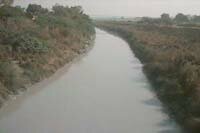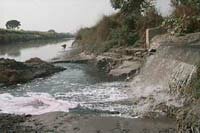DEATH OF RIVER PANDU IN KANPUR

Residents of more than 50 villages situated along the Pandu river, a tributary of Ganga which passes through Kanpur, are a disgruntled lot. They are bearing the brunt of the rampant pollution caused by the draining of ash slurry from Panki Power Thermal Plant and effluents thrown by a number of industries including some units of Ordinance into river Pandu. Even worse, tonnes of sewage are also fouling its water. No wonder, Pandu river which was known for its crystal clear water two decades back has turned black. It also stinks. The magnitude of the contamination can be gauged from the fact that many of the people exposed to the water are suffering from a host of skin problems.
Even though the deplorable condition of river water has been brought to the notice of the authorities concerned, no action has been taken in this regard. And the poisoning of Pandu continues. The biggest villain of the piece is the Panki Thermal Power Plant. According to sources, the plant uses around 3,000 tones of coal and churns out 40 tonnes of fly ash every day. The ash is dumped in a fly ash pond spread over an area of two square kilometers. The slurry overflows from the pond and finds its way into Pandu. An ambitious project for safe disposal of the fly ash is awaiting sanction from the central government.
 The source of Pandu river is a lake in Farrukhabad. The river runs for around 120 kilometres and meets the Ganga in Fatehpur. Before Pandu enters Kanpur, its water is greenish. The tonnes of fly ash slurry mingles with the river and changes its colour to silvery grey. Further downstream, when drains of domestic sewage and industrial effluent mix with the river, its water turns black.
The source of Pandu river is a lake in Farrukhabad. The river runs for around 120 kilometres and meets the Ganga in Fatehpur. Before Pandu enters Kanpur, its water is greenish. The tonnes of fly ash slurry mingles with the river and changes its colour to silvery grey. Further downstream, when drains of domestic sewage and industrial effluent mix with the river, its water turns black. The plight of the villagers is aggravated once monsoon recedes as the river water leaves behind a blanket of fly ash on a large tract of agricultural land. The ash is deposited in the fields even in the dry season as the farmers use its ash-laden water, rich in mercury, to irrigate their fields. Large deposits of such slurry can be found in these fields which have an adverse affect on productivity. Hapless villagers in the area complain that some of their lands have become uncultivable. Fly ash slurry makes the soil less porous and impedes aeration as a result of which lands turn fallow, claim the farmers. Earlier, the land along the Pandu river was known to be highly fertile. The kahars, a local backward community, were leased out the land to grow vegetables every year. However, due to pollution from Thermal Power Plant, there are no takers for the land.
The plight of the villagers is aggravated once monsoon recedes as the river water leaves behind a blanket of fly ash on a large tract of agricultural land. The ash is deposited in the fields even in the dry season as the farmers use its ash-laden water, rich in mercury, to irrigate their fields. Large deposits of such slurry can be found in these fields which have an adverse affect on productivity. Hapless villagers in the area complain that some of their lands have become uncultivable. Fly ash slurry makes the soil less porous and impedes aeration as a result of which lands turn fallow, claim the farmers. Earlier, the land along the Pandu river was known to be highly fertile. The kahars, a local backward community, were leased out the land to grow vegetables every year. However, due to pollution from Thermal Power Plant, there are no takers for the land.
Effluents generated by around 6,000 small, medium and big industrial units located in Panki and Dadanagar industrial areas are also discharged into the four nalas (storm water drains) that fall into the Pandu river. Most of these  industries are of electroplating, detergents, chemicals (processing chrome sulphate also), waste oil processing and some Ordinance units. Villagers claim that when the Gun Factory releases toxic black oil into the river, fish die in shoals. Some locals also pointed out that their cattle die within hours if they consume the river water accidentally. Despite this, the Central Pollution Control Board (CPCB) has not undertaken any study of the industrial pollution in the area, let alone the pollution of the Pandu river. In the absence of any scientific study, no one knows the exact chemical composition of the effluent and sewage being carried by the nalas into the river Pandu.
industries are of electroplating, detergents, chemicals (processing chrome sulphate also), waste oil processing and some Ordinance units. Villagers claim that when the Gun Factory releases toxic black oil into the river, fish die in shoals. Some locals also pointed out that their cattle die within hours if they consume the river water accidentally. Despite this, the Central Pollution Control Board (CPCB) has not undertaken any study of the industrial pollution in the area, let alone the pollution of the Pandu river. In the absence of any scientific study, no one knows the exact chemical composition of the effluent and sewage being carried by the nalas into the river Pandu.
 industries are of electroplating, detergents, chemicals (processing chrome sulphate also), waste oil processing and some Ordinance units. Villagers claim that when the Gun Factory releases toxic black oil into the river, fish die in shoals. Some locals also pointed out that their cattle die within hours if they consume the river water accidentally. Despite this, the Central Pollution Control Board (CPCB) has not undertaken any study of the industrial pollution in the area, let alone the pollution of the Pandu river. In the absence of any scientific study, no one knows the exact chemical composition of the effluent and sewage being carried by the nalas into the river Pandu.
industries are of electroplating, detergents, chemicals (processing chrome sulphate also), waste oil processing and some Ordinance units. Villagers claim that when the Gun Factory releases toxic black oil into the river, fish die in shoals. Some locals also pointed out that their cattle die within hours if they consume the river water accidentally. Despite this, the Central Pollution Control Board (CPCB) has not undertaken any study of the industrial pollution in the area, let alone the pollution of the Pandu river. In the absence of any scientific study, no one knows the exact chemical composition of the effluent and sewage being carried by the nalas into the river Pandu.
With the virtual death of Pandu in Kanpur, thousands of villages have lost a vital water resource. Today the locals fear to even touch the river water. In case, they venture out into the water by mistake, they develop boils and rashes on their feet. The toxicity of the water has forced them to depend on groundwater for their water needs. However, industrial pollution has taken its toll on groundwater of the area too. It is apprehended that water at the depth of around 35 feet might contain dissolved ammonia, nickel, chromium and fluoride. In such a situation, people are left with using government-installed handpumps which draw water from a depth of 100 feet.
Under Ganga Action Plan Phase II (GAP II), the government proposes to make Pandu river pollution-free. The idea is to tap the sewage falling into the Pandu river through interception and diversion and then treat the same. This treated water is proposed to be used for irrigation.
Against the backdrop of various lacunae that have turned Ganga Action Plan into Ganga Inaction Plan, a number of questions need to be addressed immediately:-
- Under GAP II, three out of the four nalas falling into Pandu river would be tapped. The fourth nala (called the IEL drain) exclusively carrying industrial effluent has been ignored completely. Thus, wouldn’t the river continue to receive the industrial waste water even after the completion of GAP II?
- Has any study been undertaken to find out the chemical composition of the domestic sewage that is proposed to be tapped and treated under GAP II? There is no segregation of domestic and industrial waste water and hence, both get mixed in the drain. This has been corroborated by the recent test results conducted by IIT-EcoFriends which revealed the presence of hazardous chemicals and heavy metals in the domestic sewage reaching the treatment plants set up under GAP I.
- Under GAP II, a 200 million litre per day (mld) treatment plant is to be set up. The technology approved for the plant is Upflow Anaerobic Sludge Blanket (UASB) in which waste is treated through the growth of anaerobic bacteria. From the experience of 36 mld Common Effluent Treatment Plant (CETP), set up under GAP I to treat tannery waste water, it is well-established that the chromium and chemicals as well as other heavy metals present in the tannery waste stream affect the functioning of the plant adversely. Shouldn’t the presence of hazardous heavy metals and other chemicals be factored in the choice of the treatment technology for treating sewage mixed up with industrial effluents? Is the UASB technology appropriate for treating 200 mld of sewage mixed with industrial waste water?
If these questions are left unanswered, there is every possibility that GAP Phase II would become a replay of GAP I. And Pandu river would remain a flowing muck.

Comments
Post a Comment